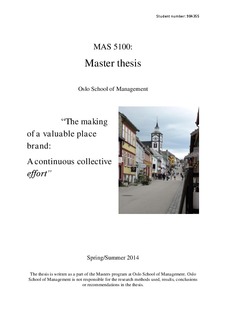The making of a valuable place brand: A continuous collective effort.
Abstract
The interest in keeping rural settlements has remained constant with the Norwegian authorities since the start of the industrialization. Despite the fact that cities have grown and continue to grow while the rural areas are depopulated. However, some rural areas have not experienced depopulation and blossomed instead. These notions are the background for this thesis. The thesis aims at establishing a ―continuous collective effort‖ as a concept and a success factor for rural areas which have enjoyed a stabile population. Moreover, the thesis explores how the ―continuous collective effort‖ started and what sustains it over time.
The thesis uses brand and place branding theory to explore the proposed concept of ―continuous collective effort‖. Having an attractive place brand is suggested as a reason for success. The thesis uses a case study approach with a focus on interviews, observations and archival records. The case studied is the municipality of Røros that had its cornerstone factory closed down in 1977 and several more close downs during the 1980s and 1990s.
Overall, the data from Røros support the concept proposed as the data suggests that Røros works collectively towards a socially agreed brand. Further, the data suggest that the collective effort is rooted in a shared history and identity. Furthermore, the data suggests that the collective effort has been sustained through the collective awareness of the place brand and the emphasis on shared history and identity. The data also suggests that the municipality authorities‘ recent involvement of the inhabitants in a long term plan connects people together and strengthens their attachment to the place. The identity and history is reinforced by outsiders‘ view of the place and internal and external institutions function as conservational forces. The study`s limitations as well as future research is discussed.
